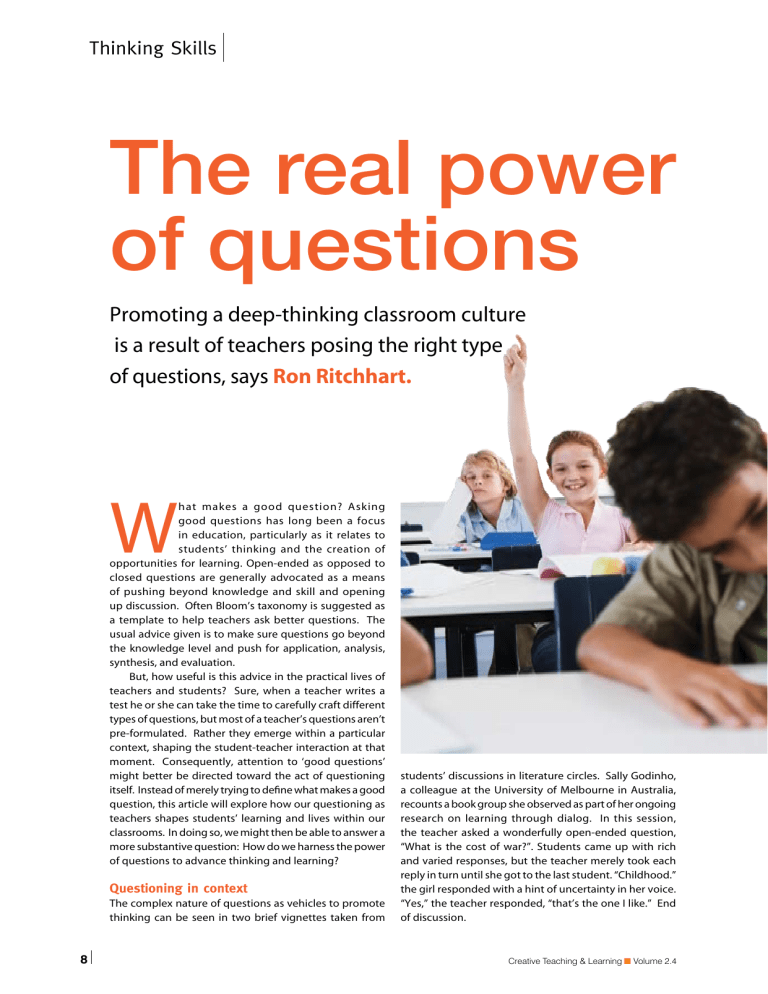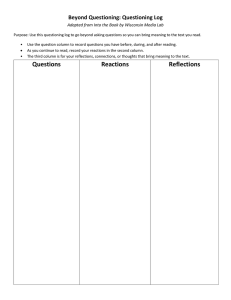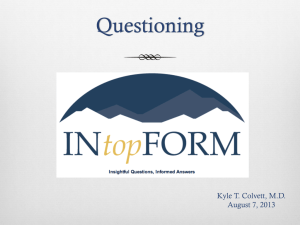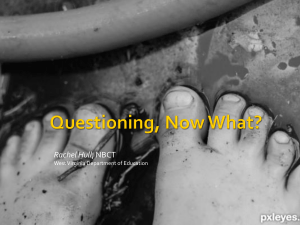The real power of questions

Thinking Skills
The real power of questions
Promoting a deep-thinking classroom culture
is a result of teachers posing the right type of questions, says Ron Ritchhart.
W hat makes a good question? Asking good questions has long been a focus in education, particularly as it relates to opportunities for learning. Open-ended as opposed to students’ thinking and the creation of closed questions are generally advocated as a means of pushing beyond knowledge and skill and opening up discussion. Often Bloom’s taxonomy is suggested as a template to help teachers ask better questions. The usual advice given is to make sure questions go beyond the knowledge level and push for application, analysis, synthesis, and evaluation.
But, how useful is this advice in the practical lives of teachers and students? Sure, when a teacher writes a test he or she can take the time to carefully craft different types of questions, but most of a teacher’s questions aren’t pre-formulated. Rather they emerge within a particular context, shaping the student-teacher interaction at that moment. Consequently, attention to ‘good questions’ might better be directed toward the act of questioning itself. Instead of merely trying to define what makes a good question, this article will explore how our questioning as teachers shapes students’ learning and lives within our classrooms. In doing so, we might then be able to answer a more substantive question: How do we harness the power of questions to advance thinking and learning?
Questioning in context
The complex nature of questions as vehicles to promote thinking can be seen in two brief vignettes taken from students’ discussions in literature circles. Sally Godinho, a colleague at the University of Melbourne in Australia, recounts a book group she observed as part of her ongoing research on learning through dialog. In this session, the teacher asked a wonderfully open-ended question,
“What is the cost of war?”. Students came up with rich and varied responses, but the teacher merely took each reply in turn until she got to the last student. “Childhood.” the girl responded with a hint of uncertainty in her voice.
“Yes,” the teacher responded, “that’s the one I like.” End of discussion.
Creative Teaching & Learning n Volume 2.4
Thinking Skills
In contrast, Sally witnessed another teacher stop her group’s reading after they came across a passage in which one character was compared to a vulture. “What is a vulture?” she asked, merely trying to clarify the analogy with a simple, knowledge-based question. What ensued was a rich discussion of the traits of vultures and how the character had some of those traits. This was followed by the group’s generation of alternative metaphors. These two instances of teacher questioning drive home the point made by Dillon (1994), ‘It makes no difference whether the question is higher or lower cognitive, whether it is simple or complex, whether it is fact or interpretation. What makes the difference is whether the answer to the question is predetermined to be right, whether it is to be recited or discussed’ 1 .
As Sally’s examples illustrate, good questions, that is questions that drive learning, don’t come from some
Modeling intellectual engagement
Vygotsky (1978) famously wrote, ‘Children grow into the intellectual life of those around them’ 5 . As teachers, we are always serving as models for our students, demonstrating what it means to think, learn, and create within the particular discipline we teach. Our students learn how to engage with ideas through paying attention to our own engagement. Asking authentic questions, that is, questions that the teacher does not already know the answer to or to which there are not predetermined answers, is extremely powerful in creating a classroom culture that feels intellectually engaging. Such questions allow students to see teachers as learners while fostering a community of inquiry.
John Threlkeld, an algebra teacher in Denver, Colorado is a master of this. In observing his classroom over the course of a year, I often noticed he generally began his prescribed list or simplistic set of guidelines. They arise from our motives as teachers, operate as classes with questions such as, ‘You know, I was wondering
As teachers, we are always serving as models
if that pattern we looked at yesterday might be part of a dialog we initiate present in any of the other with students, and exist
for our students, demonstrating what it
situations we have looked within a larger classroom at in this unit, what do you culture that privileges
means to think, learn, and create within the
think?’ Or, ‘Yesterday Amy the exploration of ideas. found an interesting way of
Furthermore, asking good
particular discipline we teach
approaching the problem, questions is only a start and I was wondering if that when it comes to promoting thinking, one must also listen to students’ answers and use them as a basis for prodding and probing students’ thinking. If, as teachers, we don’t listen to students’ thoughts, then we will be hard pressed to put forth questions that pushes them to elaborate or clarify their thinking. A good question can lead students down a certain path, but we as teachers must be ready to follow.
Using questions to promote thinking
Questions are the prime way teachers interact with students in classrooms. Our questioning helps to define our classrooms, to give it its feel and energy—or lack thereof. As such, questions are culture builders.
Within this context, we need to understand how their use can help us foster a culture of thinking, that is, help us create a place in which the group’s individual as well as collective thinking is valued, visible, and actively promoted as part of the regular day-to-day experience of all group members. A productive way of approaching this matter is through the examination of our motives and goals as teachers for questioning in the first place.
Specifically, this article will explore how teachers can use questions in different contexts to achieve four specific goals around thinking: 1) to model intellectual engagement with ideas, 2) to promote and nurture ongoing inquiry, 3) to support students in constructing understanding, and 4) to help students clarify their own thinking to themselves and others. would always work?’. Martin Nystrand (Nystrand, Gamoran,
Kachur, & Prenergast, 1997) and his colleagues have shown that these kinds of authentic questions, though exceedingly rare in most classrooms, have a positive influence on student engagement, critical thinking, and achievement since they help to promote class inquiry and discovery, framing learning as a complex, multi-faceted, communal activity as opposed to a process of simply accumulating information.
Good ‘essential questions’ can fall into this category as well if they have the power to open up the learning for everyone - including the teacher. In her 9th grade humanities class, Kathy Hanawalt at Clover Park High
School outside of Tacoma, Washington uses a set of essential questions to focus her students on the fundamental issues of truth, perspective, and universality that lie at the heart of history and literature. Above her whiteboard on construction paper are five questions:
What’s the story? What’s the other story? How do you know the story? Why know/tell the story? Where’s the power in the story? These questions serve as the touch points for ongoing exploration of everything that happens in the class.
When Kathy first began using the questions in her class, she found that looking at the other or hidden story to understand not only what the history students were studying, but also those events around them, was particularly captivating for her students. Even in simply sharing a personal anecdote, she found that students were likely to ask the class, “Yeah, but what’s the other
Volume 2.4
n Creative Teaching & Learning
Thinking Skills
10 story?”. This question became essential and generative to students’ learning. When reading accounts of history, current events, or political essays, the notion that there is another story and that uncovering it is necessary to truly understand people and events propelled learning and engaged students in Kathy’s classroom. Using questions such as these supports students learning of how to learn by sending messages that learning history involves uncovering the multiple stories that exist.
Promoting inquiry
The provenance of authentic questions doesn’t rest solely with the teacher, however. When students ask authentic questions, that is, questions they have a genuine interest in pursuing, we know they are focused on the learning and not just the completion of assignments. Fourth grade teacher, Michele Alt from Way Elementary in Bloomfield
Hills, Michigan is used to beginning her units of inquiry in science by having students ask questions. These questions are often generated by using a thinking routine such as
Think-Puzzle-Explore 3. However, at times she felt the questions generated weren’t as rich as she hoped. To address this, Michele chose to make the construction of questions an ongoing part of her units.
Reflecting on this shift, Michele states, “I feel like I have gotten better questions by asking students to question after a specific experience, rather than just have them think about a general topic and ask questions.” As an example, one student began the unit on matter by posing the question, “What happens when something turns to ashes? Is that matter?”. However, after doing a short reading about matter, the student revised the question,
“What I really meant is what is disintegration? Can matter disappear?”. This reframing of the question made it more generative in that it helps to build deeper understanding of the topic for everyone. Other students generated completely new questions based on the reading. For instance one student wrote, ‘The article says wishes aren’t matter. I think wishes take up space in your mind. Why aren’t wishes matter?’.
Michele and her class then took a look at all the questions they had assembled at this point in the unit and used the Question Sorts routine (see Figure 1) to determine how ‘genuine’ and ‘generative’ the questions were. Michele explained that genuine questions were ones you cared about as opposed to those just made up because the teacher asked you to come up with some questions. She defined generative questions as those that ‘generate a deeper understanding, new possibilities, creative action, or insight’ as well as ‘the I-never-thoughtof-it-that-way- questions’.
In reflecting on the insights she gets from students’ questions, Michele commented, “I get to glimpse inside the minds of ten year-olds and uncover some of their misconceptions. These questions are great to me as a teacher. I never would have known that some children think of wishes or light as ‘taking up space’. But, after hearing their questions, I understand why it is confusing and complex. Also, students were thinking that matter can be ‘felt’. Those questions sparked a great class conversation.” As Michele indicated, students’ questions can be a good measure of their intellectual engagement and understanding. Middle School Science teacher, Paul
Cripps from Wyoming, echoes this sentiment. He believes that students’ questions are his best assessments of their learning, “I judge my students not by the answers they give, but by the questions they ask,” he says.
Constructing understanding
Our research team recently looked at teacher questioning as part of the ‘Cultures of Thinking Project’ at Bialik
College in Melbourne, Australia. We observed that when teachers focus on making thinking valued and visible in their classrooms, their questioning shifted away from asking review or knowledge based questions to asking more constructive questions (Note: more facilitative questions were also asked, these will be discussed in the next section). Constructive questions can be thought of as those that help to advance understanding. These are questions that ask students to connect ideas, to make interpretations, to focus on big ideas and central concepts, to extend ideas, and so on.
Constructive questions act, not as nice add-ons to make sure some so-called higher-order thinking is happening, but as the guideposts and goals for the lesson itself. Teachers’ constructive questions navigate the important ideas and conceptual anchors in such a way as to ensure that students do not miss them. Whereas teachers asking review type questions tend to do so because they want to determine what students know and remember, teachers ask constructive questions because they want to guide, direct, and push forward students’ understanding of important ideas.
With her first grade class at the International School of Amsterdam, Stephanie Martin’s students were learning
Creative Teaching & Learning n Volume 2.4
Thinking Skills about their senses. One of the goals of the unit was for students to be able to connect each of their senses with what kinds of information can be gathered from it. In one particular lesson, Stephanie’s students felt an object in a box and then described aloud what kinds of things they felt: squishy, soft, round edges, corners, and so on.
Based on these responses, Stephanie then asked students to begin to make interpretations and assumptions, ‘What do you already know just by feeling it?’. Followed up by,
‘What do you not know by feeling it?’ and, ‘What does your feeling of it make you wonder?’. These questions might not seem complex or difficult on the surface, but they go to the heart of what it is Stephanie wants her students to understand: What information do we get from each of our senses; and what can we do with that information?
Without such questions the activity of feeling a mystery object would be little more than a game and unlikely to yield much learning.
Constructive questions frame the intellectual endeavour in which students are to be engaged and point them toward uncovering fundamental ideas and principles that aid understanding. This may seem like a tall order to place on teachers’ shoulders; however, this is precisely where ‘Thinking Routines’ developed by the
Visible Thinking Team and Cultures of Thinking Project at Harvard Project Zero 3, 4 can be useful. The steps of each of the routines outline a set of constructive moves that students can make to facilitate their understanding and make their thinking visible. In Stephanie Martin’s lesson, she adapted the See-Think-Wonder routine into
Feel-Think-Wonder. Her initial question, ‘What did you feel when you reached into the mystery box?’ directs students to making observations based on touch.
Then, ‘What do you think about what you felt?’ moves students towards interpretations and the exploration of possibilities. Finally, Stephanie asked her students, ‘What are you left wondering about the object in the box given that we were only able to feel it?’ tone with people and invites them to elaborate on and clarify their ideas in a non-threatening way. Although, ‘Tell me why?’ or ‘Give me your reasons and evidence for that statement’ serve the same role, they seem not to carry the same level of openness and interest.
This simple yet powerful question is a perfect example of the kind of question that can facilitate and clarify the learner’s own thinking. In using facilitative questions the teacher’s goal is to try and understand students’ thinking, to get inside their head, and make their thinking visible.
Jim Minstrell, a former secondary science teacher who now directs research efforts in science education aimed at uncovering students’ thinking, studied his own teaching and carefully examined the way he interacted with his students at Mercer Island High School in Washington state through his questioning. He coined the term ‘reflective toss’ to describe the questioning sequence he uses to facilitate and clarify students’ thinking 6 .
Traditionally, researchers have often characterized the discourse of the classroom as originating with the question a teacher asks. However, Jim took students comments and ideas as the starting point for dialog. In the reflective toss, the teacher’s first goal is to try and
‘catch’ students’ meaning and try and understand their comments. If meaning can’t be grasped immediately, then a follow up question, such as, ‘Can you say more about that?’ or ‘I’m not quite following you, can you say what you were thinking in a different way?’ is asked. Once the meaning is grasped by the teacher, then the teacher
‘tosses’ back a question that will push the student to further elaborate and justify his or her thinking, both to the teacher and to oneself. For instance, Jim might ask a student, ‘What does that tell you then?’; ‘What do you think you were basing that on?’ or even the old stand by,
‘What makes you say that?’. The idea is to push the student to think further about his or her response. This strategy will be familiar to those who have used the Socratic method or Philosophy for Children program.
Facilitating and clarifying thinking
‘What makes you say that?’ This question is often one of the most fully integrated thinking routines in the classrooms of teachers with whom we have worked in developing cultures of thinking. At Lemshaga Akademi in
Sweden where the Visible Thinking work first began, the teachers took to referring to this question as the ‘magic question’ because they found that by using it regularly in their interactions with students a great deal of thinking was revealed. As a result, teachers were easily able to enter into a dialog with students around ideas.
At Bialik College one teacher remarked that ‘What makes you say that?’ isn’t just a teaching tool; it is a way of life. She said she learns so much more and has much deeper conversations with friends and family just by asking, ‘What makes you say that?’ instead of responding right away to people’s comments. Teachers remark that the wording of this question seems to strike just the right
Questions as Culture Builders
All teachers want to ask good questions, the kind that can drive learning and elicit deep thinking. However, to truly harness the power of questions we must keep in mind that questioning isn’t an isolated enterprise or something merely to pencil in as part of a lesson plan. Questioning is the chief way in which teachers and students interact around content. They are the vehicles by which we direct attention, foster understanding, push beyond simplistic answers, and expose students’ thinking.
Furthermore, we must recognise that the questions we ask as teachers exist within a larger classroom culture we are trying to create. In every instance, a teacher’s question is the outward manifestation of a much larger motive and agenda about learning, its purposes, and its processes.
Consequently, the kinds of questions we ask and the way we respond to students’ answers communicate whether the classroom culture we are creating is one that promotes
Volume 2.4
n Creative Teaching & Learning
11
Thinking Skills learning as a process of merely adopting the ready-made ideas of others - i.e., playing guess what’s in the teacher’s head - or is one that privileges the exploration of ideas within a community of inquiry and forming one’s own judgments and interpretations.
Ron Ritchhart is a Fellow at the University of
Melbourne and Senior Research Associate and
Principal Investigator of the Cultures of Thinking
Project at Project Zero, Harvard Graduate School of
Education; 617-495-4898; ron@pz.harvard.edu.
Author’s note: Some of the ideas and research reported here were developed with support from
Bialik College and Abe and Vera Doravitch. The views expressed by the author are not necessarily those of the funders. Some of these ideas were first reported in the book Making Thinking Visible (2011).
References
1) Dillon, J. T. (1994). Using discussion in classrooms.
Oxford: Open University Press.
2) Nystrand, M., Gamoran, A., Kachur, R., & Prenergast,
C. (1997). Opeing dialogue. New York: Teachers
College Press.
3) Ritchhart, R., Church, M., & Morrison, K. (2011).
Making thinking visible: How to promote engagement, understanding, and independence for all learners. San
Francsico: Jossey-Bass.
4) Visible-Thinking-Team (2007). Visble Thinking
Retrieved November 26, 2008, 2008, from www.
pz.harvard.edu/vt
5) Vygotsky, L. S. (1978). Mind in society. Cambridge,
MA: Harvard University Press.
6) Zee, E. v., & Minstrell, J. (1997). Using questioning to guide student thinking. The Journal of the Learning
Sciences, 6(2), 227-269.
Knowledge Trails
1) What if heaven is full? – Encouraging the art of question-asking to get children thinking ‘outside the box’ http://library.teachingtimes.com/articles/whatifheavenisfull.htm
2) Any questions? – A case study on what happened when an AST adopted a questioning culture in her classroom http://library.teachingtimes.com/articles/students-ask-questions.htm
3) Developing curious minds - Steve Williams suggests strategies for enabling students to ask good questions http://library.teachingtimes.com/articles/students-ask-questions.htm
4) Questions - the key to unlocking potential - If someone could ask you a question right now about your own skills in developing others, what would that question be? Next to listening, questioning may be the most important skill for a coach. http://library.teachingtimes.com/articles/coaching-teachers-potential.htm
Article from School Leadership Today (Access by subscription)
This series is based on Edward de Bono’s
Thinking Hats concept
Thinking Hats
By Anna Forsyth
All books priced at £17.99 each
Thinking Hats - Book 1 Ages 5-7
Thinking Hats - Book 2 Ages 7-9
Thinking Hats - Book 3 Ages 9-11
Creativity is the wealth of tomorrow. Developing laterality in approach to issues is exciting, challenging and critical learning. World-renowned
Edward de Bono’s concept of ‘Thinking Hats’ has proven itself to be an excellent way to ensure that students consider problems and issues from different perspectives; ‘actively thinking’.
This series of three books teaches the use of Edward de Bono’s six thinking hats; white for facts and information, yellow for optimism, green for creativity, blue for the overall picture, black for negative, red for emotions.
A series of 40 lessons in each book spans almost all the curriculum areas so that students practice using thinking hats in many contexts.
Order Now: Tel: 0121 224 7599 Fax: 0121 224 7598 or Email: enquiries@imaginativeminds.co.uk
12
Thinking Hats half.indd 1
Creative Teaching & Learning n Volume 2.4
9/2/12 10:46:22


